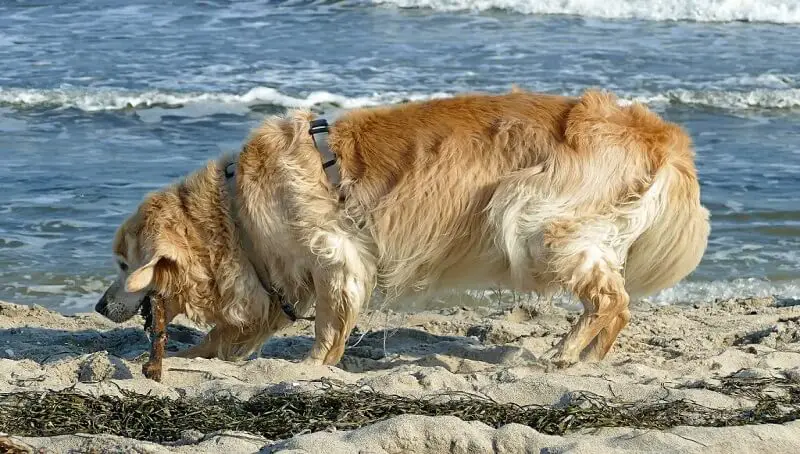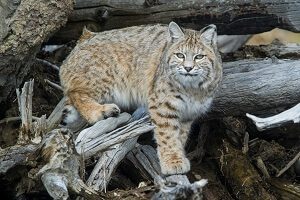
Can Dogs Eat Seaweed Sheets?
September 28, 2022
Obesity Treatments: Tipping the Scale for Fat Dogs
September 28, 2022
The red lynx is part of the order of Carnivora, the Felidae family, and has the scientific name Felis rufus. The risk of extinction of this species is low. In Mexico, the red lynx is often captured by farmers for both its beautiful fur and revenge because it attacks domestic animals and birds, especially sheep and turkeys.
Also called a bobcat, this medium-sized feline has its tail as short as a tuft and the edge of its face as a collar. Mainly reddish in color, it always has some spots, more prominent, all over its body or just on the lower side.
It hunts eastern burrow rabbits in the south of its habitat, and American rabbits in the north. But it can also feed on rodents, deer, and herons. Its habitat ranges from desert to mixed forested lands and coniferous forests.
Where does the bobcat live?
The bobcat is a feline that can be found in an area that spans more than 2,5 million km², comprising the southern half of North America, especially southern Canada and central Mexico, east and west of the United States.
You might also like my articles with facts about the manatee, lemmings, or frogfish.
Its habitat is varied. It lives in areas with milder, wetter climates, snowy rocky places, and canyons in the southeast of America, in subtropical forests, bare mountain slopes, in swampy places, or with deserted soil where cacti grow. They avoid areas that are too wet or dry.
How to identify a bobcat
This carnivorous animal has a typical lynx appearance. It is 65-110 cm long, weighs 4-15,5 kg, and has a tail length of 11-19 cm.
It does not have fur as thick as its northernmost relatives, but it is as fluffy and warm and impresses with shades of reddish or slightly yellow colors, with numerous gray or dark spots. The ears are much shorter than in the case of the common lynx and are provided with dark tassels.
The tail is quite long. At the bottom, it has a dark shade, often black, and this is also a characteristic sign of the red lynx. The jaws are equipped with a number of 30 very sharp teeth, also a characteristic of carnivorous prey animals, and the paws are endowed with retractable claws.
What does a bobcat eat?
Its food consists of mice, squirrels, small mammals and rodents, hedgehogs, wild birds, bats, snakes, lizards, otters, and field rabbits. Sometimes it also attacks domestic animals like sheep and goats, or poultry, chickens, and turkeys, and when it has the opportunity, it does not hesitate to catch any kind of insect or even domestic cats.
In rare cases, they also eat fruit, the only green food they prefer. The bobcat eats a lot, about 1,4 kg of meat at one meal, and when it is full, it leaves its prey, then returns the next day to finish it.
Behavior
The bobcat is a solitary, terrestrial and twilight-loving animal, hunting especially at night, sometimes in the morning. During winter it also goes hunting during the day. In order to search for its prey, it travels about 50 km or more, being an extremely mobile animal. The bobcat has favorite places to rest, and trails that it constantly uses.
It is an excellent climber, but it climbs only in search of food and shelter. The red lynx also knows how to swim. During summer it washes its fur in shallow waters and sometimes it can make ample leaps to pass to the other side of a small pond. When walking on the ground, it treads carefully like a feline, so that no creaking of branches is heard as in other animals.
The bobcat attacks the prey with hard, sharp claws, suddenly jumping on it, then bites it with its fangs right in the neck area on the dorsal side.
Vision and hearing are well developed. It hunts on the ground, sneaking on its prey. With its sharp claws, the bobcat holds the victim and stops it with a bite. As a meal, an adult animal eats up to 1,4 kg of meat. The remaining surplus is hidden and the red lynx returns to it the next day.
During walking, the bobcat places its hind legs exactly in the tracks left by the front legs. The soft cushions on its feet help it to quietly sneak up on its prey at a close distance.
It marks the boundaries of its hunting area with urine, feces, and the secretions of the skin glands. It also leaves claw scratches on the trees’ trunks. The size of the marked area depends on the amount of food available.
How does a bobcat hunt?
 A red lynx can move silently through the forest, chasing its favorite prey, the rabbit. It is able to detect small animals even under a layer of snow or hear and see them in complete darkness. The favorite prey of the red lynx is the American wild rabbit. When the red lynx hunts it, it relies more on sight than on hearing.
A red lynx can move silently through the forest, chasing its favorite prey, the rabbit. It is able to detect small animals even under a layer of snow or hear and see them in complete darkness. The favorite prey of the red lynx is the American wild rabbit. When the red lynx hunts it, it relies more on sight than on hearing.
It also feeds on squirrels and other rodents, and occasionally attacks wild turkeys, domestic chickens, and even white-tailed deer and sheep.
The bobcat is able to detect small mammals even under the snow, where they hide in burrows. The lynx undoubtedly finds its victims through barely audible sounds that come from under the snow. The number of red lynx and field rabbits is always dependent on each other. When there are many field rabbits, then bobcats breed well. As the number of field rabbits decreases, so does the number of bobcats.
Reproduction
During the reproductive period, the male and female can be observed together in the spring months. The female makes between 2 and 6 blind kittens in a litter, but usually, there are 2-4, after a fairly short gestation period of about 50 or 60-70 days, in this regard, the researchers’ opinions are different. The male reaches the age of reproductive maturity after 2 years and the female after 1 year.
In order to raise their young, the female nests in a cave or in a large hollow of a secular tree. At birth, the offspring are 340 g or less, blind and helpless. After 10 days they begin to see. Breastfeeding lasts up to 8 weeks and the cubs gain weight of about 25 g per day.
After 2-3 months they are weaned, then they are taught by the mother to catch their prey. In the first week, the prey is caught only by the mother and brought to the offspring. From the age of 3 to 5 months, kittens go hunting with their mother. At the age of 9 months, they are completely independent and acquire their own hunting ground.
Who hunts a bobcat?
The enemies of a bobcat are the jaguar, puma, Canadian lynx, coyote, and wolf.
Life Span
The life expectancy of a bobcat is 15-20 years in the wild and about 32 years in captivity. Its greatest enemies are man and the above-mentioned wild animals. The owl and the fox mainly hunt their young.
Population/conservation status:
The current population size is 725.000 to 1.000.000 mature individuals. The approximate area of the range is over 2.500.000 km2. The species is listed in the CITES Convention.
Facts
The red lynx can be bred in captivity by humans and can be quite a nice domestic animal, but with wild grasps.
On hot days, the bobcat cools in pools and lakes, as it is an excellent swimmer, but on less warm days it runs away from water.
The red lynx is a night predator. During the day it is seen very rarely, and in some periods, not at all.
To hunt, males need more than 100 square miles, and even enter the territory of another male, while females have half the territory of a male and never enter the territory of another female. A male can have 2-3 females in his hunting space.
A male can take care of even 3 nests with cubs, having to provide daily food to each.
